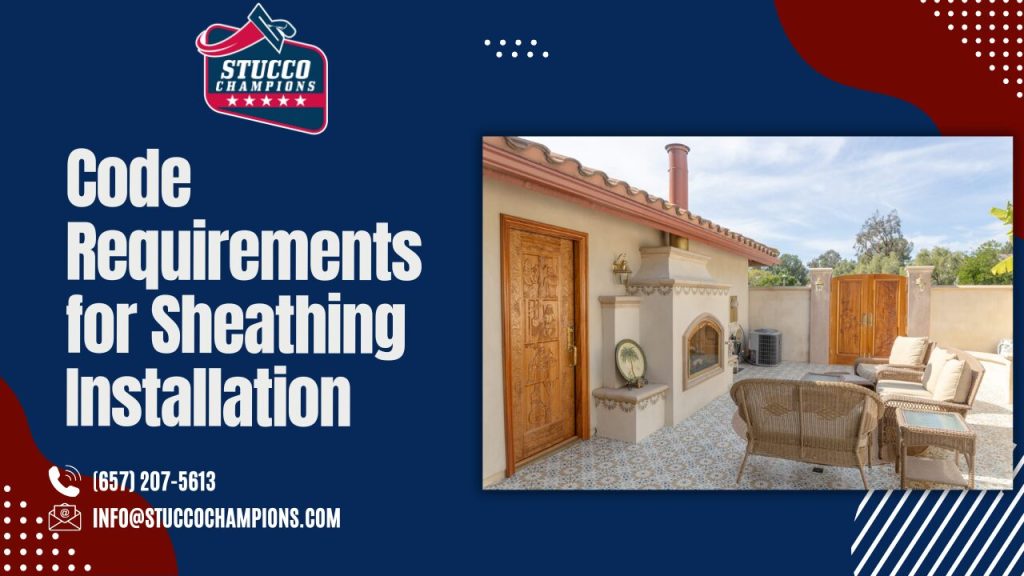Code Requirements for Sheathing Installation
Correct sheathing installation is a foundational part of any successful stucco or exterior wall project. Sheathing not only provides structural support, but also plays a major role in weather resistance, energy efficiency, and long-term durability. Whether you’re using OSB, plywood, or gypsum board, complying with code requirements is essential for performance and passing inspection.
This guide outlines essential sheathing requirements based on the International Residential Code (IRC), the APA – The Engineered Wood Association, and best industry practices. This information is especially helpful for general contractors, stucco professionals, inspectors, and anyone involved in structural exterior work.
What Types of Sheathing Materials Are Code-Compliant?
Building codes allow the following sheathing materials, depending on structural and fire requirements:
-
Oriented Strand Board (OSB) – Most common choice for wall and roof sheathing
-
Plywood – Preferred for applications needing greater moisture resistance
-
Gypsum Sheathing – Used in fire-rated wall assemblies
-
Foam Board Insulation – Used for thermal resistance but not structural support
All materials used must be APA-rated or meet equivalent third-party performance standards. Look for grade stamps with thickness, span rating, and exposure classification (Exposure 1 or Exterior).
Minimum Thickness Requirements by Application
Panel thickness varies based on application and framing spacing. Below are general IRC-compliant guidelines:
Wall Sheathing:
-
For 16-inch OC studs: minimum 7/16-inch OSB or plywood
-
For 24-inch OC studs: minimum 1/2-inch plywood or thicker
Roof Sheathing:
-
16-inch OC rafters: minimum 7/16-inch OSB or 3/8-inch plywood
-
24-inch OC rafters: minimum 19/32-inch OSB or 5/8-inch plywood
Floor Sheathing:
-
Typically 23/32-inch tongue-and-groove plywood or OSB for subfloors
These thicknesses are based on APA and IRC span ratings. Always confirm local amendments, especially in high-load areas.
Nailing and Fastening Schedule
Proper fastening is critical for structural integrity and code compliance. Here’s a general code-approved nailing schedule:
Wall Sheathing:
-
Nail edges every 6 inches
-
Nail field every 12 inches
Roof Sheathing:
-
Nail edges every 6 inches
-
Nail field every 12 inches
Fastener Type:
-
Use 8d common nails (2½ inches) or screws as approved
-
Nails must not be overdriven or underdriven. Use depth-controlled nail guns to ensure compliance.
Note: High-wind and seismic zones often require denser nailing (e.g., 4 inches on edges).
Proper Panel Orientation
For maximum strength and code compliance:
-
Install panels perpendicular to framing members (joists, studs, or rafters)
-
Stagger seams so vertical joints don’t align between courses
Improper orientation can compromise structural performance and lead to inspection failures.
Expansion Gaps and Spacing
Building codes and APA guidelines recommend spacing sheathing panels to account for expansion:
-
Leave a 1/8-inch gap at all panel edges and ends
-
Use H-clips or spacers between roof panels if specified
This prevents buckling during temperature or moisture changes.
Regional Considerations: Wind, Seismic, and Moisture Zones
Building code requirements vary by region:
Seismic Zones:
-
Shear walls may require continuous blocking, tighter nail spacing, and specialized hold-downs
High-Wind Areas:
-
Panels may need to be nailed every 4 inches on edges
-
Reinforced fastening patterns or hurricane clips may be required
Moisture-Prone Zones (e.g., coastal or humid climates):
-
Use Exposure 1 or Exterior-rated panels
-
Install water-resistive barriers (WRBs) over sheathing before stucco
Fire-Rated Assemblies and Sheathing
For multifamily or commercial structures:
-
Use Type X gypsum sheathing where 1-hour or 2-hour fire ratings are required
-
Fire-treated plywood may be specified by code for certain assemblies
Inspection Checklist for Sheathing Installation
Before finalizing your sheathing work, ensure the following to pass inspection:
-
Grade stamps visible on all sheathing panels
-
Panels installed with correct orientation and spacing
-
Proper nail or screw size and pattern used
-
Fasteners flush with the panel, not overdriven
-
Blocking and tie-downs installed if required
-
Water-resistive barrier installed where applicable
Final Thoughts
Whether you’re prepping for stucco installation or managing structural framing, proper sheathing installation is non-negotiable. Code-compliant sheathing helps protect your investment, pass inspections, and deliver long-term performance on every project.
For contractors like Stucco Champions who prioritize lasting quality, proper sheathing is the foundation of every exterior wall.
Ready to Simplify Your Stucco Work?
Contact Stucco Champions today for a free consultation!
Visit us at Stucco Champions for helpful resources and to learn more about our services.


